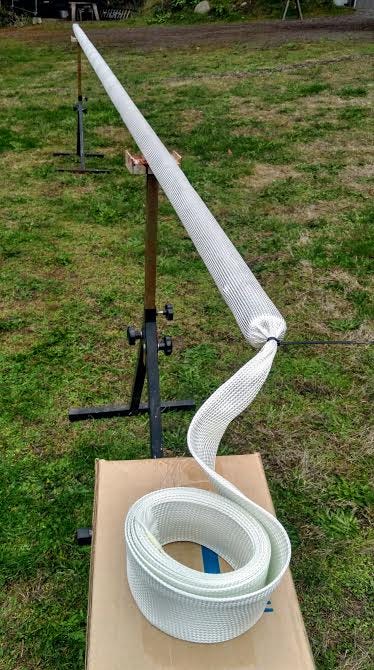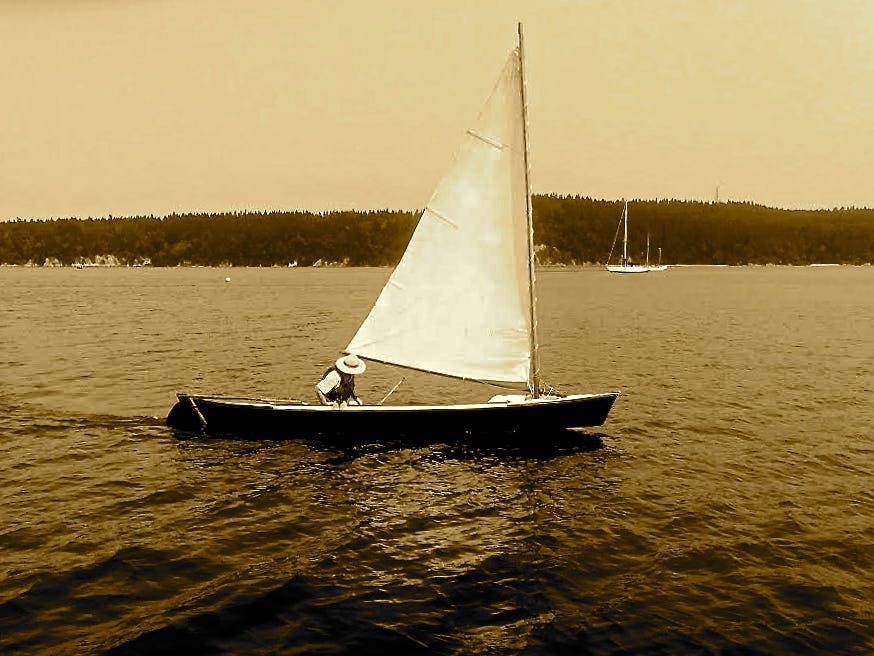Considering the motley variety of rotten boats I’ve dragged home to restore—and typical condition of their weak, weathered spars—it’s amazing I’ve never experienced total failure of a mast, gaff, yard, boom or other important stick of wood. I’ve mainly focused on hull repairs, electrical, plumbing and mechanical messes, and refinishing…blissfully ignoring spars that often deserved but rarely got enough attention.
There was one notable exception, when my latest “save” was a 20-foot Chesapeake Crabbing Skiff, built 50-some years earlier to a late-1800’s design. The flat-bottomed hull was heavy, strong and mainly needed a total refinish, but the tall, unstayed mast, cracked in several places, was horribly weathered and appeared especially vulnerable in one spot where it had snapped in two and had been scarfed together in a questionable manner. It was time to either shape a new mast or figure out how to save the old thing.
The cure turned out to be a biaxial fiberglass-sleeve product—a tight-fitting fabric tube that can be pulled over any kind of spar (broken paddles, oars, masts or whatever), then glassed with multiple coats of epoxy resin to dramatically increase strength of any weakened or broken shaft. The product, known officially as Braided Biaxial Fiberglass Sleeving, is available from Duckworks Boat Builders Supply (duckworks.com) in five inside-diameter sizes: 1-1/2”, 2”, 2-1/2”, 3” and 4”…with the first three sizes in 10-oz. cloth and the last two in heavier 15-oz. fabric. Price per foot varies from $1.19 to $3.79, depending on diameter.
So, to apply, you first make sure the wooden shaft (mast, in my case) is fairly smooth and free of splinters that might snag on the tubular cloth as it’s pulled carefully over length of the spar. If your spar is tapered, the idea is to start easing the cloth over the skinny end, gently massaging the fabric forward until you’re close to the far end. As you pull the cloth forward (rubber dishwashing gloves, nice and sticky, help give you traction during the process), the cloth shrinks tightly over the spar, becoming snug…just like the Chinese finger-trap toys we recall from childhood.
The real trick is guessing how many linear feet of biaxial cloth you need for your spar. We recommend reading the product’s full description on the Duckworks website, but here’s an excerpt that might help when calculating the length needed: “We found a rule of thumb we can apply to all available sizes—when covering an object that is the same diameter as the sleeving, a nominal foot of sleeving will cover only 8 inches. When covering an object that is half the diameter of the sleeving, a nominal foot will cover 12 inches. For anything in-between, you can extrapolate as the change is somewhat linear. At any rate, we suggest adding at least 10% for error.”
And finally, from Duckworks: “There is one more thing you may want to consider and that is orientation of the strands. While it’s true that the sleeving is biaxial, the angles change as the material is stretched. So, if you have two choices of size, it may make sense to get the larger diameter sleeving and stretch it farther to get the strands running more along length of the spar for greater strength.”
The attached photos show the Chesapeake Crabbing Skiff we restored, and the unstayed mast we repaired, along with images illustrating the process of stretching the sleeve over the mast and pulling it snugly in place. One of the images is a closeup
showing a section of the mast after the first coat of resin cured. (At this stage the fiberglass wrap has a lot of texture. Additional coats of resin will reduce the texture, and so will a few thick coats of primer, applied before painting the spar.) The mast can be left with a clear appearance, of course, but if you choose to apply varnish over the epoxied surface, but sure to use polyurethane varnish for at least the first coat, since it’ll adhere better than traditional spar varnish. After the first coat of polyurethane, you can continue with poly or switch to spar varnish for remaining coats.
The finished mast was stunningly strong compared to the cracked and weak old thing I started with. The final test was an overnight cruise with friends at Lake Ozette, in Olympic National Park, where we enjoyed strong, gusty winds and a rousing sail back to the launch ramp on Day 2. The mast held up brilliantly under terrific stress, giving me confidence to recommend biaxial sleeving the next time you need to repair a broken, cracked or weathered old spar.
You can find details at www.duckworks.com •SCA•









Great article Marty. If someone elects to finish the spar clear, remember it is epoxy coated so UV protection is essential and if covering with good spar varnish (UV protection), it needs to be seen to every year or so to keep up the UV protection. Of course if using paint, white or otherwise, the epoxy may be better protected.
Man, this is the coolest stuff!! While I have an aluminum rig, this is just fantastic! Technology applied while still the "old school" appearance. And it makes the boats even more dependable. I love articles like this! I thought I wasn't going to like the transition from print to digital. Big surprise, I'm liking it better than I thought. Looking forward to the 2023 Salish 100 where we'll get our restored WWP 15 on the water after over 25 years. Really enjoying all the articles!! Keep up the good stuff!